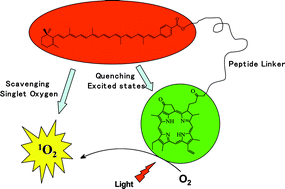Using the singlet oxygen scavenging property of carotenoid in photodynamic molecular beacons to minimize photodamage to non-targeted cells†
Abstract
We recently introduced the concept of photodynamic molecular beacons (PMB) for selective control of photodynamic therapy (PDT). The PMB consists of a peptide linker that is sequence specific to a cancer-associated protease. A photosensitizer (

- This article is part of the themed collection: Photodynamic Therapy and Photodetection

 Please wait while we load your content...
Please wait while we load your content...